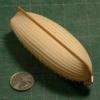-
Posts
13,290 -
Joined
-
Last visited
Content Type
Profiles
Forums
Gallery
Events
Everything posted by druxey
-
Thank you for my morning smile, Ed. I love the little adjustable jig!
- 3,618 replies
-
- young america
- clipper
-
(and 1 more)
Tagged with:
-
Beautiful work, Amalio!
-
Usually there was a small eyebolt (called a sprig) in the end of the gaff with a small single block attached. The halliard, as mentioned above, was continuous. It might belay to a small cleat or eyebolt aft.
-
It certainly can be interesting figuring out the lead of lines until nothing fouls anything else. A belaying plan from Grice would have been nice, wouldn't it? I can see you are having fun, Maury!
- 525 replies
-
- anchor hoy
- hoy
-
(and 1 more)
Tagged with:
-
I have used professional museum and art object movers in the past. They are bonded and insured and are used to packing, crating and moving delicate items. However, they are not cheap.
-

ancre Chebece 1750 by Jeronimo - FINISHED
druxey replied to Jeronimo's topic in - Build logs for subjects built 1501 - 1750
Beautifully executed, Karl. -
I knew that your hull planking was individually laid with self-adhesive foil, but not the decks as well. Impressive!
- 1,035 replies
-
- royal katherine
- ship of the line
-
(and 1 more)
Tagged with:
-
Questions, questions - always more questions! I agree that those slides would have been ideal to hold the lower halfport/washboard. With gravity, there would be no need to hinge them. I still feel that a ready source of splinters would have been stowed away when clearing for action. The upper halves must have been detachable.
-
I didn't realize that the decks are individually laid strips. Beautifully done.
- 1,035 replies
-
- royal katherine
- ship of the line
-
(and 1 more)
Tagged with:
-
I hate to criticize a lovely job but, to my eye, the run of plank into the bow rabbet looks a little steep. Is the top of the main wale at the correct height or a little too high? If it's not exactly right (as I discovered from personal experience) the headwork will not sit correctly at the bow. Hopefully it's just due to camera angle or distortion.
-
Are you planning on leaving the model au naturel or will you be painting her?
- 281 replies
-
- falls of clyde
- tanker
-
(and 2 more)
Tagged with:
-
The size of that recovered deadeye is strange. The photos show a groove about 11cm in diameter, or a little over 4" This implies that the line around the deadeye would be in the order of 12". According to Steel, a 100 (or 110) gun ship had 17" deadeyes and 11" shrouds. Is it possible that this artifact did not, in fact, come from Colossus?
About us
Modelshipworld - Advancing Ship Modeling through Research
SSL Secured
Your security is important for us so this Website is SSL-Secured
NRG Mailing Address
Nautical Research Guild
237 South Lincoln Street
Westmont IL, 60559-1917
Model Ship World ® and the MSW logo are Registered Trademarks, and belong to the Nautical Research Guild (United States Patent and Trademark Office: No. 6,929,264 & No. 6,929,274, registered Dec. 20, 2022)
Helpful Links
About the NRG
If you enjoy building ship models that are historically accurate as well as beautiful, then The Nautical Research Guild (NRG) is just right for you.
The Guild is a non-profit educational organization whose mission is to “Advance Ship Modeling Through Research”. We provide support to our members in their efforts to raise the quality of their model ships.
The Nautical Research Guild has published our world-renowned quarterly magazine, The Nautical Research Journal, since 1955. The pages of the Journal are full of articles by accomplished ship modelers who show you how they create those exquisite details on their models, and by maritime historians who show you the correct details to build. The Journal is available in both print and digital editions. Go to the NRG web site (www.thenrg.org) to download a complimentary digital copy of the Journal. The NRG also publishes plan sets, books and compilations of back issues of the Journal and the former Ships in Scale and Model Ship Builder magazines.


